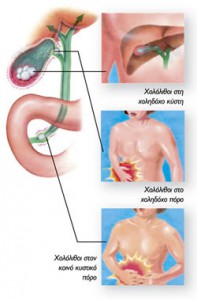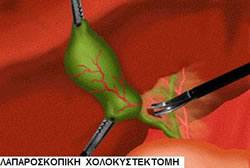Gallbladder
The gallbladder (commonly known as gall bladder) is a pear-shaped organ, located under the right side of the liver.
Its main function is to collect part of the digestive fluid (bile), which is produced in the liver.
When necessary, this fluid is released from the gallbladder after meals, to help the digestion mainly of fatty substances. Bile flows into the small intestine through narrow tubular canals, namely the cystic and bile ducts.
Cholelithiasis
Problems in the gallbladder usually arise from the presence of choleliths (gallstones).
These are mainly formed of cholesterol and bile salts in the gallbladder or the bile duct.
The causes of cholelith formations are unknown; hence, there is no way to prevent them.
If gallstones migrate to the bile duct, they block the flow of bile to the bowel and cause gallbladder swelling, resulting in sharp abdominal pain, vomiting, dyspepsia and, in some cases, fever.
Furthermore, blocking of the common bile duct due to gallstones may result in jaundice (a yellowish tint of the skin) or pancreatitis.
The presence of gallstones may be symptomatic (sharp abdominal pain, vomiting, dyspepsia, flatulence, etc.), but many times it can also be asymptomatic.
An Ultrasound is the safest, most painless and cost-effective diagnostic method.
Gallbladder removal surgery is the most appropriate and safest treatment for cholecystitis, and it does not cause digestion disorders in most patients.
In the past, gallbladder removal involved a big incision, hospitalization for several days and much post-operative pain.
Things changed in the 1990’s and, fortunately, since 1989 the laparoscopic surgery is performed.
Laparoscopic Cholecystectomy
The appearance of the revolutionary method of laparoscopy at the beginning of the 90’s changed the facts about cholecystectomy.
In this method, a laparoscope (a small telescope connected to a special camera) is inserted through a tube of 5-10 mm in diameter. It allows the surgeon to see the patient’s internal organs 10-15 times bigger than they really are.
Other tubes of 3-5 mm in diameter are simultaneously inserted in the abdomen, and the doctor can work internally through them.
If the surgeon determines that intraoperative cholangiography or endoscopic exploration of the bile duct (choledoscopy) is needed, this can be done through the same incisions.
However, due to special conditions this method cannot be applied to a very small percentage of patients (less than 1%) -when there is a specialized surgical team. The surgeon may then opt to switch to an “open” surgery before or even during the operation.
Advantages of laparoscopic cholecystectomy over open surgery
• Minimum surgical trauma (one 1 cm incision and three 0.5 cm incisions)
• Quick recovery
• No blood loss
• Patient can leave the hospital quickly
• Less hospitalization costs
• Quick return to work
• 10-15 times more enlarged image and better lighting
• Minimum postoperative pain
• Postoperative complications with regard to the trauma (purulence, disruption, hernia, chronic pain, etc.) are almost completely eliminated.
• Less respiratory and cardiovascular complications
• Reduced possibility of postoperative adhesion development
• Possible to treat patients with severe problems, such as patients who underwent cardiothoracic surgery, obese patients or patients in Intensive Care Unit.
Complications are very rare in laparoscopic cholecystectomy, and patients return to their regular activities very quickly. They are discharged from the hospital the next day.
Single-incision Laparoscopic Cholecystectomy and Robotic Cholecystectomy
The advancement of laparoscopy allows surgery via only a single, small incision through the navel (single port), while no other small incisions required. This offers an excellent aesthetic result.
Lately, the robotic method is also used for gallbladder removal.






